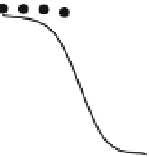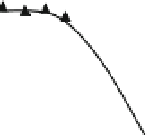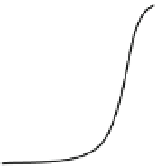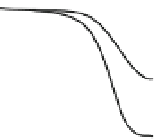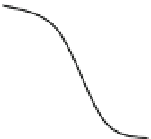Biology Reference
In-Depth Information
a
b
c
0
0
0
-25
-25
-25
-50
-50
-50
-75
-75
-75
-100
-100
-100
-7
log NYC292005 [M]
-6
-5
-4
-7
-6
-5
-4
-7
-6
-5
-4
log NYC92338 [M]
log NYC118277 [M]
d
e
300
0
200
-25
-50
100
-75
0
-100
-7
-6
-5
-4
-7
-6
-5
-4
log NYC57569 [M]
log NYC57569 [M]
Fig. 5 Retest of compounds using the PDE5-GAF-CyaB1 malachite assay at 10 or
100
m
M cGMP. (a) NYC92338 is an example for a group of compounds that inhibit mainly the
adenylyl cyclase. (b) NYC292005 is an example for a group of compounds that inhibit both the
adenylyl cyclase part of PDE5-GAF-CyaB1 and the GAF domain. (c) NYC118277 is an example
for a group of compounds that inhibit cyclase activation via the GAF-tandem domain.
(d) NYC57569 is an example for a group of compounds that inhibit the chimeric PDE5-GAF-
CyaB1 protein in spite of activation of the adenylyl cyclase part of PDE5-GAF-CyaB1 shown in
(e). 0% activity corresponds to the average signal obtained with a positive control. An activity
of
100% corresponds to the average signal obtained with a negative control. Test conditions/
symbols for a-d:
closed circles
100 ng PDE5-CyaB1 protein, 10
m
M cGMP,
open triangles
1
m
g
PDE5-GAF-CyaB1, w/o cGMP,
filled triangles
40 ng PDE5-CyaB1, 100
m
M cGMP
The last group of 57 compounds clearly inhibited activation of the GAF domain
and did not interfere with adenylyl cyclase activity. These compounds are less
active in the presence of 100
m
M cGMP compared to 10
m
M cGMP and are,
therefore, expected to compete with cGMP for binding to the GAF domain.
NYC118277 (Fig.
4
) is a representative for this last group: It is considered to be
competitive with cGMP because it inhibited more potently at 10
m
M cGMP
(logIC
50
¼
5.8) than at 100
m
M cGMP (logIC
50
¼
5.2) and not at all in the
absence of cGMP (Fig.
5c
).
Taken together the high-throughput screen and further testing using the PDE5-
GAF-tandem-CyaB1 adenylyl cyclase chimera identified four classes of compounds
that may be of future interest for different reasons. Foremost, the identification of
compounds that clearly stimulate or inhibit class III adenylyl cyclases is exciting
because all mammalian adenylyl cyclases are class III isoforms. It would be worth-
while to investigate whether these compounds have similar inhibitory effects on the
nine isoforms of the mammalian membrane-bound adenylyl cyclases.
